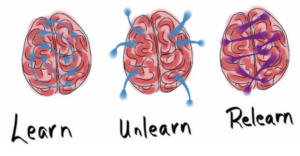
“The illiterate of the 21st century will not be those who cannot read and write, but those who cannot learn, unlearn, and relearn. ”
– Alvin Toffler
Elizabeth Quinn an exercise physiologist and sports medicine writer characterizes “Agility” as an ability that permits you to respond to what is going on around you, take in information, and in a controlled manner, translate it into body positioning that will place you in the right position to take the next action effectively. No less is true for organizations. An agile organization can move along with the changes in their industry and the world as a whole. There isn’t a fear of change and workflows are easily adaptable to change. An agile organization is one that is stable at its core but can quickly change to meet any needs of the environment. Can the same be said of your ability to move, change direction, and position yourself for the next opportunity? How is your agility, or more specifically, how agile is your ability to learn?
At one point in time this retail giant dominated the market with 3600 stores; today there is one, located in Bend, Oregon. Do you remember Blockbuster? What happened? According to Geoff Graves, former director of Operations at Blockbuster, Inc., “We were just hit from everywhere. It was Redbox. It was Netflix. It was pay-per-view, Direct TV. Boy, it just came from all sides.” Well, here’s the reality, the next big change is almost upon us and the last thing you want to be saying is, “I never saw it coming!” The question becomes, how can we increase our capacity to learn, to spot and understand developments inside and outside of the organization, or more simply, how can we use experiences as a means of fostering our capacity for rapid, continuous learning? Monique Valcour’s HBR’s post, 4 Ways to Become a Better Learner provides some insights.
Valcour proposes that our learning agility is a key factor to our success in a market economy that is subject to continuous change. She suggests that agile learners are good at making connections across experiences and they’re able to let go of perspectives or approaches that are no longer useful; that is, when faced with a novel situation, they can unlearn or let go of things that may have worked in the past. Agile learners focus on and derive satisfaction from the learning process itself. They take risks by experimenting with new approaches or behaviors. They seek feedback and embrace a growth mindset. They seek connections that are not obvious to others, and they invest time in reflection.
Experimenting With New Approaches or Behaviors – David Peterson, director of executive coaching and leadership at Google reminds us, “Staying within your comfort zone is a good way to prepare for today, but it’s a terrible way to prepare for tomorrow.” Sometimes the best thing we can do is create discomfort. It can be as simple as asking the question, “What is one thing that could be done that will change the outcome or give us something different? This can be especially challenging when the status quo is working for you.
Seek Feedback and Embrace a Growth Mindset – Talk to others and ask for honest, direct feedback. Make sure to solicit their input on how you could have done things differently. Restrain the urge to defend your actions or decisions; this is learning time. Remember that a growth mindset embraces the perspective that learning is a never-ending experience. The process of wading into the unfamiliar serves to free our thinking, dissolve our fear of failure, and empower our success.
Seek the Connections – Think about it, how does one develop expertise in any field? It is through a series of experiences combined with comparisons, discussion, reflection and reapplication. Sometimes we need only look at what has made us successful in one endeavor and seek to apply those ideas and lessons to another. Many of the connections will not be obvious at first, but study and discussion can lead to an “ah-hah” moment.
Create Time for Reflection – There is no shortage of research demonstrating that systematic reflection on work experiences boosts learning significantly. By simply asking, “What have I learned from this experience?” or “What turned out differently than expected?” facilitates the process of continuous learning. This becomes critical for organizational leaders as their behaviors become the model for others thereby laying a foundation that embraces learning agility as an organizational value.
The greatest danger any of us can face personally or professionally, is missing out on opportunities because we avoid questioning ourselves or intentionally moving outside of our comfort zone. By becoming an agile learner we embrace discomfort because it gives us greater perspective. It opens the door to approaches we’ve never tried or even thought of, and it gives us fresh eyes and a whole new perspective on the world. Now there’s an opportunity!
EMBRACE THE CHALLENGE
